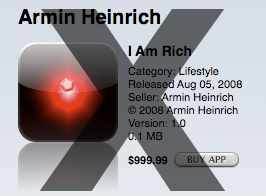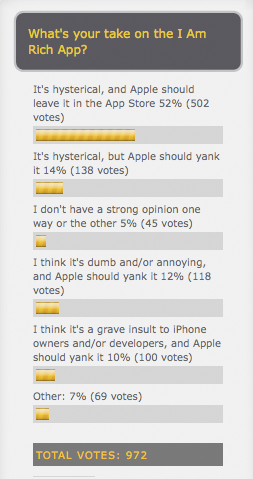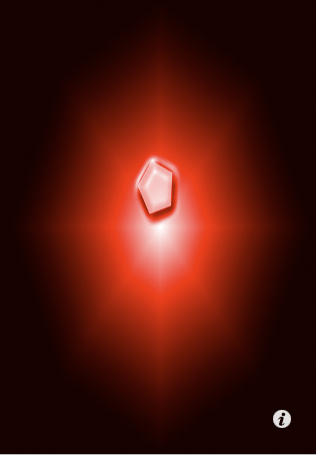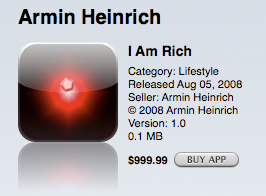 Hey, I have news this morning about the T-List itself! It’s now available in RSS feed form for your daily (well, Monday through Friday) reading pleasure. Thanks to T-Reader Brad Mays for the suggestion.
Hey, I have news this morning about the T-List itself! It’s now available in RSS feed form for your daily (well, Monday through Friday) reading pleasure. Thanks to T-Reader Brad Mays for the suggestion.
Continue Reading →
Tag Archives | iPhone
iPhones at Best Buy? Cool! Probably!
 [Update on the post below: MacNN says it’s confirmed that Best Buy will start selling the iPhone in early September.)
[Update on the post below: MacNN says it’s confirmed that Best Buy will start selling the iPhone in early September.)
AppleInsider is reporting that Best Buy may be about to announce that it will begin selling iPhones. I have no idea whether that’s true, but it’s certainly plausible enough: It’s safe to assume that the phone will eventually be available at venues other than Apple Stores and AT&T shops, and Best Buy is both the nation’s 800-pound gorilla of electronics retailing and one of the few places other than Apple Stores to stock a relatively generous selection of Apple products.
If the rumor pans out, it’s good news on a number of fronts. More choices when it comes to buying stuff are always better than fewer (even if the increased competition doesn’t result in the iPhone being available for less than $199, which I suspect it won’t). The more iPhones that are sold, the likely it is that software develpers and accessory manufacturers will jump on the bandwagon; that would be a boon to everyone who’s bought an iPhone anywhere.
And if the iPhone ends up sitting on a counter alongside other phones from multiple manufacturers and carriers, I think it’ll prompt Apple’s competitors to move even more quickly than they have been to try and match or exceed everything that’s good about the iPhone–its industrial design, its screen and interface, its media features, and, most of all, the fact that it’s a full-bodied software platform. For that reason, I hope that the iPhone lives in Best Buy’s phone section, rather than off with other Apple products.
(When CompUSA was a national chain with an “Apple shop” tucked in the corner of the showroom floor, Macs and other Apple products were segregated from more mass-market rivals. It’s quite possible that Apple insisted on this approach, but every CompUSA Apple shop I ever saw was a ghost town; I would have much rather have seen MacBooks and iMacs alongside machines from HP, Gateway, and Sony, where people who didn’t think they wanted a Mac might have discovered them.)
With the iPhone 3G’s current Apple-and-AT&T-only retail availability, the phone gets tender loving care unlike that of just about any consumer product I can think of. The Apple Store folks are able to devote huge resources to marketing and explaining the thing, which is obviously part of why it remains a phenomenon a month after it went on sale. (Just this last weekend, I saw a line of buyers snaking out of the Apple Store in the Fashion Show Mall on the Las Vegas Strip.) And while it’s far from the only phone at AT&T stores, it’s clearly the only superstar there, and receives a lot of TLC: When I walk into an AT&T shop, I’ve sometimes had a greeter suggest I look at iPhones the moment I cross the threshold.
My impulse was to be worried that Best Buy, or just about anyone other than Apple and AT&T, might struggle with the iPhone simply because mass-market retailers are usually so very bad at giving their customers actual authoritative advice about the products they hawk. That’s been an issue with other Apple products in the past, and was presumably a major reason why Apple made the surprising (and amazingly successful) decision to open its own stores. And while Best Buy apparently staffs at least some of its stores with dedicated Apple experts, the ones I’ve happened to visit have had Apple sections that looked like smaller, tidier versions of the ghost towns I remember from CompUSA.
But as I think about it, I’m not sure if the iPhone needs that much explaining. It’s more of an iPod than a Mac–a product that’s extraordinarily well-known, with benefits that are pretty easy to get without much explanation. The $199 price is competitive, too–there shouldn’t be any equivalent to scenarios in which someone looks at a $1100 MacBook and a $600 HP notebook and can’t grasp why the MacBook might be worth the dough.
So I’m hoping that Best Buy is indeed about to roll out the iPhone. But here’s what would please me even more: Amazon.com selling the iPhone. I can’t believe that the requirement that the phone be activated will keep it off the Web forever, and I don’t think anyone (aside from Apple) would do a better job of selling it on the Web.
On the other hand, this post at Ars Technica’s Infinite Loop mentions the possibility of RadioShack selling iPhones. I find that kind of horrifying, although I can’t quite articulate just why. Maybe it’s because I’ve so rarely encountered a RadioShack clerk whose customer-service skills go much beyond telling me where the AAA batteries are. Or perhaps it’s because I’ve been into computers for so long that when I think of Apple and RadioShack, I think of the wars between Apple II and TRS-80 owners, of which I remain a bloodied, battered veteran who’s prone to the occasional painful flashback…
No comments
In Australia, the iPhone 3G Isn’t “Twice as Fast.”
 Two things are pretty much undeniable about Apple ads:
Two things are pretty much undeniable about Apple ads:
1) When discussing technical specifications, the company likes to make bold claims, and…
2) It doesn’t like to use footnotes, qualifiers, or disclaimers to get around the fact that virtually no claim you can make about a technology product is equally true in all circumstances.
That’s how you get a commercial like this iPhone spot (titled “Unslow”), which shows someone zipping around the Web on an iPhone more quickly than I’ve ever been able to in real life, and which ends with the tagline: “The new iPhone 3G: The Internet–you guessed it–twice as fast.”
If I’d tried to recreate that 30-second ad with my iPhone 3G during my trip to Las Vegas this weekend, it might have been a three-minute ad…even though I was on 3G at the time. on
A bit of type at the end of the ad does say that 3G isn’t available in all areas. But an iPhone 3G ad that aimed to set consumers’ expectations realistically would have pointed out that there are entire states–ten of ’em–in which the iPhone 3G can’t get on a 3G network, and that even when you’re on a 3G network, it doesn’t guarantee that your experience will be “twice as fast.”
(You also gotta wonder how they filmed that ad: Is that really the AT&T network in action? Did they do multiple retakes and choose the fastest one? When they shot the ad, did they choose a studio which they knew to have superb AT&T 3G coverage? In what percentage of instances across the country will the New York Times load as quickly as it did in that ad?)
Apple’s whole “Twice as fast” iPhone 3G mantra (also prominent on its home page as I write this) seems incredibly dangerous for Apple: Since it’s not true when stated that definitively, it sets up consumers who don’t know a lot about 3G service for disappointment. Simply put, it’s selling people on something very specific which the iPhone 3G–as wonderful as it is in most respects that matter–doesn’t deliver.
While poking around YouTube looking for the above commercial, I first found the version that airs in Australia. For the most part, the Australian “Unslow” is a faithful remake of the U.S. edition. But there is one crucial difference, other than the cool Aussie voiceover:
Yup–in Australia, the iPhone 3G is merely “really fast.” And Apple’s home page for Australia doesn’t use the “Twice as fast. Half the price” tagline at all:

In fact, I see that the Apple sites for the UK, France, Italy, and our neighbor to the north don’t use the “Twice as fast” claim either.
I don’t know for sure why this is. Maybe the math of Apple’s EDGE-vs-3G comparison for AT&T’s network doesn’t hold up even in a theoretically perfect scenario in other countries. (I can see why Apple wouldn’t want to use a slogan like “1.87 Times as Fast. .624 the Price.”) Perhaps Apple’s ad agencies in other countries are more cautious. Laws about what you can and can’t claim in an ad may vary.
Back in the U.S., Apple could have made its claim about the iPhone 3G’s speed entirely defensible if it had said something along the lines of “Up to twice as fast.” It chose not to. Like I said, this is a company that just doesn’t like footnotes, qualifiers, or disclaimers…even when they’d turn a claim from questionable to accurate.
Oddly enough, there’s another type of Apple ad, equally common, that avoids all these issues: The ones that are purely based on an emotional appeal, such as all those iPod ads that do absolutely nothing except show people enjoying music. Betcha you could make an iPhone commercial that was similar in spirit to those ones–and it might even sell just as many phones as “Unslow” will.
UPDATE: Jason Fried, who mused about “Unslow” before I did, pointed me to this video in which someone tried to recreate the ad on AT&T’s 3G network in Boston. The results are…well, unfast:
FURTHER FURTHER UPDATE: Close examination of the high-res versions of the U.S. and Australian editions of “Unslow” reveal a very similar, remarkably steady hand. If that is the same hand model in both spots–and I’m not saying it is–were the ads actually shot in the U.S. and Australia, using the cell networks the iPhone 3G is available on in those countries? Conspiracy theorists, elaborate!
FURTHER UPDATE: On Apple’s site, it accompanies the online version of “Unslow” with a disclaimer: “Based on 3G and EDGE testing. Actual speeds vary by site conditions. Based on iPhone 3G (8GB) and first-generation iPhone (8GB) purchases. Requires new 2-year AT&T rate plan, sold separately.” Not very Apple-ish, but shouldn’t it be in the commercial itself?
One comment
iPhone 3G and AT&T: Imperfect Together?
CNET’s Tom Krazit and Marguerite Reardon have publishing a lengthy and interesting story reporting on widespread gripes about the iPhone 3G losing its connection. The article provides no definitive conclusions on what the root of the problems might be–or even just how pervasive they are–but theorizes that the iPhone may do a poor job of switching between AT&T’s 3G network and its older and slower EDGE network on the fly. It’s important that a phone be able to do that as seamlessly as possible, since AT&T 3G is so far from universal.
It’s always dangerous to come to any conclusions about a technology product or service based solely on one’s own experience with it, but my own experience with my own iPhone 3G hasn’t seemed any glitchier than the time I spent with an A&T Tilt, the phone I used immediately prior to buying the iPhone. Almost of all my first month with the iPhone was spent in the Bay Area; there were plenty of times when I could only get an EDGE connection, but I don’t recall any instances of phone calls or data connections conking out on me.
On the other hand, I just got back from a weekend in Las Vegas, and there I did have AT&T issues there. The very first call I made as I walked through McCarran Airport got cut off, and even though my iPhone consistently told me I was on AT&T’s 3G network, the connection was often excruciatingly, unusably slow. On Saturday, I happened to be in the Fashion Show mall on the Strip, and was amazed to see that the Apple Store there still had a lengthy line of folks waiting to buy iPhones; I felt like asking for their attention and telling them that my experience with an iPhone in Vegas had been less than satisfactory…
3 comments
The App-Happy World of iPhone Users
 The iTunes App Store is off to a good start. Wonder how many of the 60 million apps downloaded to date are in active use? And how quickly, if at all, the downloading frenzy will start to tail off?
The iTunes App Store is off to a good start. Wonder how many of the 60 million apps downloaded to date are in active use? And how quickly, if at all, the downloading frenzy will start to tail off?
Continue Reading →
3 comments
Google Translate Where I Need It: On My iPhone
 Here’s a small bit of good news: If you’ve got an iPhone and use Google’s Google Translate service, you now get a version with an extremely iPhone-friendly user interface.
Here’s a small bit of good news: If you’ve got an iPhone and use Google’s Google Translate service, you now get a version with an extremely iPhone-friendly user interface.
It’s a Web app rather than an iPhone app, which makes sense, since it supports 24 languages and presumably relies on dictionaries and translation techniques that would be tough to squeeze onto the iPhone. But Google has done a nice job of tailoring everything to the iPhone’s screen size and touch interface–I can’t imagine that a pure iPhone version would be any easier to use. And it stores your past translations locally, so you can go back to ’em at any time. (Hey, if I knew it was possible to do that with the iPhone’s Safari, I’d forgotten.)
Here’s a peek at how it all looks:

I’m a good example of a person who really needs this service, and is utterly unqualified to review it: I’m lousy with languages, and therefore can’t really judge the quality of Google’s translations. I’m going to Berlin later this month, though, and am looking forward to giving Google Translate for the iPhone a try then–and hoping that the data charges for international roaming aren’t too onerous.
Google, by the way, is quietly doing some really excellent work with phone-specific versions of its services. Google Maps is terrific on multiple mobile platforms, including BlackBerry, Windows Mobile, and Palm. And the version of Gmail you get when you visit the service in the iPhone’s Safari is so good that I’ve been using it, rather than the iPhone’s Mail application, to manage my e-mail. When the day comes that most of our computing is done on handheld devices rather than PCs, I think there’s a good chance that Google, in all its forms, will be just as indispensable as it is today.
No comments
This is My Last “I Am Rich” Post–I Swear!
…or, at least, the last one until further developments demand additional coverage.
I don’t know anything about the application‘s developer, Armin Heinrich. But it’s intriguing that his name includes the phrase “I Am Rich,” with the letters slightly rearranged.
Oh, and “Armin Heinrich” is also an anagram of “A Rich Inner Him.” With I Am Rich gone from Apple’s App Store, though, Heinrich’s wealth may be destined to be spiritual rather than in the form of great wads of cash derived from iPhone application sales…
2 comments
I Am Rich…and Missing!
 Armin Heinrich’s I Am Rich iPhone application, which put a pretty red jewel onto your iPhone screen for $999.99, is no longer available on Apple’s App Store. No word on whether Apple or Heinrich removed it, but it ignited a firestorm and the consensus in the blogosphere seemed to be that it made both Apple and Heinrich look bad, so its departure is logical enough.
Armin Heinrich’s I Am Rich iPhone application, which put a pretty red jewel onto your iPhone screen for $999.99, is no longer available on Apple’s App Store. No word on whether Apple or Heinrich removed it, but it ignited a firestorm and the consensus in the blogosphere seemed to be that it made both Apple and Heinrich look bad, so its departure is logical enough.
For what it’s worth, Technologizer visitors seem to have healthy senses of humor, or at least mischievous ones: Of the nearly one thousand people who have participated in my little poll so far, the majority think that I Am Rich was a hoot and didn’t want Apple to yank it. Here are full results to date:

No comments
The First $1000 iPhone Application
iPhone developer Armin Heinrich has released an application for the iPhone with two noteworthy characteristics:
1) Its primary function is to display a handsome glowing red jewel on your iPhone’s screen:

2) It sells on Apple’s App Store for $999.99, thereby explaining its name: I Am Rich:

(Okay, it does have one other feature: If you touch the “i” in the lower right-hand corner, you get “a secret mantra…[which] may help you to stay rich, healthy, and successful.” Unless Heinrich decides to hand out reviewer’s copies of I Am Rich, I may never learn what that mantra is.)
Heinrich, incidentally, also sells an iPhone calculator app which, at $4.99, most likely appeals to a wider, less well-heeled audience.
Apple’s policy for approving or rejecting iPhone apps has been a bit fuzzy: It keeps approving and unapproving Nullriver’s NetShare tethering utility, and pulled the seemingly innocuous Box Office movie info app. It seems possible that whatever person or automated system put I Am Rich on the App Store was asleep at the proverbial wheel. But if I it stays up–and I have to confess that the jokester in me kinda-sorta hopes it does–one thing’s clear: Practical jokes are acceptable.
At first, all this reminded me of the days when lots of wiseacres put stuff on eBay ranging from babies to kidneys to pieces of space station Mir to their own souls. The auctions sometimes got bids in the thousands, tens of thousands, or millions of dollars; eBay tended to look askance at such hijinks, and shut down the sales as quickly as it could. But those auctions differed from Heinrich’s offering in at least two crucial ways: The items in question were usually illegal or impossible to sell, and “bids” were clearly pranks that eBay would never have enforced.
Heinrich’s app. on the other hand, is real and seemingly clearly explained, and the App Store presumably automatically charges your credit card once you agree to buy it. Wonder if anyone who isn’t rich has been silly and/or bold enough to make the purchase?
(Via Daring Fireball’s John Gruber on Twitter.)
Further thought: Other than me, most of the people who are blogging about this seem to think it’s an obnoxious travesty, and possibly insulting to iPhone developers who are trying to sell real apps. The non-jokester in me see the point. Betcha it gets pulled down–if nothing else, the hassle of dealing with anyone who “accidentally” buys it isn’t worth the pain for Apple…and neither is the distraction from all the useful, worth-the-money iPhone apps out there.
Further further thought @ 8:19pm: Hey, let’s conduct a poll!
Further further thought @ 4:26pm on 8/6: I Am Rich is now missing from the App Store. Big surprise!
57 comments
MobileMe’s Harshest Critic: Steve Jobs?
 It’s a little eerie to hear Steve Jobs say that an Apple product is anything less than incredible. But he’s apparently giving the troublesome MobileMe a dose of tough love. This and other news after the jump.
It’s a little eerie to hear Steve Jobs say that an Apple product is anything less than incredible. But he’s apparently giving the troublesome MobileMe a dose of tough love. This and other news after the jump.
Continue Reading →
